sensor Oldsmobile Achieva 1995 Owner's Manuals
[x] Cancel search | Manufacturer: OLDSMOBILE, Model Year: 1995, Model line: Achieva, Model: Oldsmobile Achieva 1995Pages: 340, PDF Size: 16.99 MB
Page 31 of 340
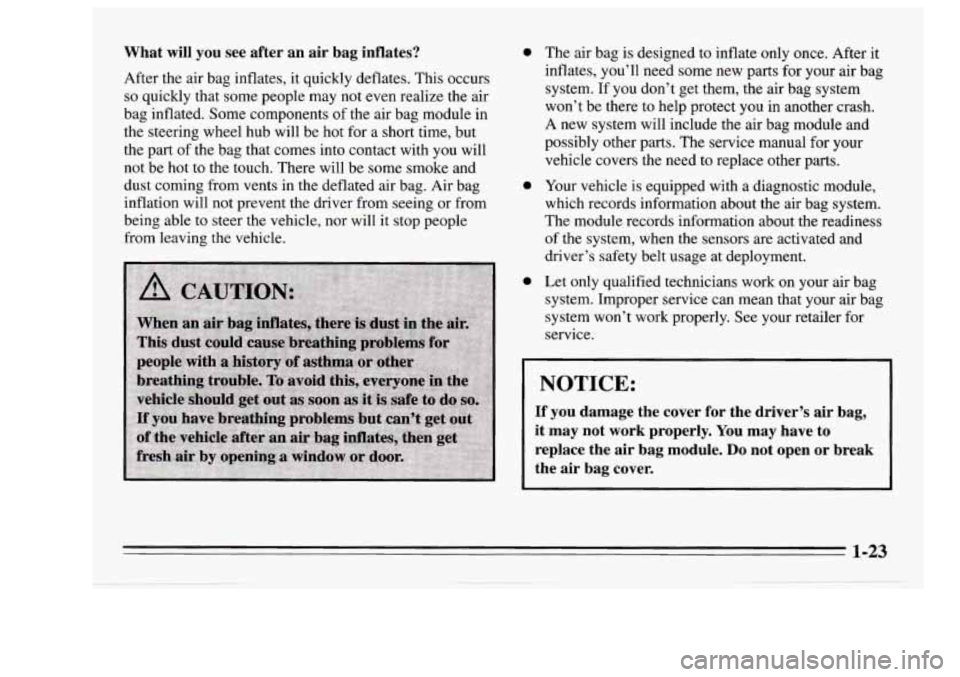
What will you see after an air bag inflates?
After the air bag inflates, it quickly deflates. This occurs
so quickly that some people may not even realize the air
bag inflated. Some components of the air bag module in
the steering wheel hub will be hot for a short time, but
the part
of the bag that comes into contact with you will
not be hot to the touch. There will be some smoke and
dust coming from vents in the deflated air bag. Air bag
inflation will not prevent the driver from seeing or from
being able to steer the vehicle, nor will
it stop people
from leaving the vehicle.
0
0
0
The air bag is designed to inflate only once. After it
inflates, you’ll need some new parts for your air bag
system. If you don’t get them, the air bag system
won’t be there to help protect you in another crash.
A new system will include the air bag module and
possibly other parts. The service manual for your
vehicle covers the need to replace other parts.
Your vehicle is equipped with a diagnostic module,
which records information about the air bag system.
The module records information about the readiness
of the system, when the sensors are activated and
driver’s safety belt usage at deployment.
Let only qualified technicians work on your air bag
system. Improper service can mean that your air bag
system won’t work properly. See your retailer for
service.
I NOTICE:
If you damage the cover for the driver’s air bag,
it may
not work properly. You may have to
replace the air bag module.
Do not open or break
the air bag cover.
Page 77 of 340
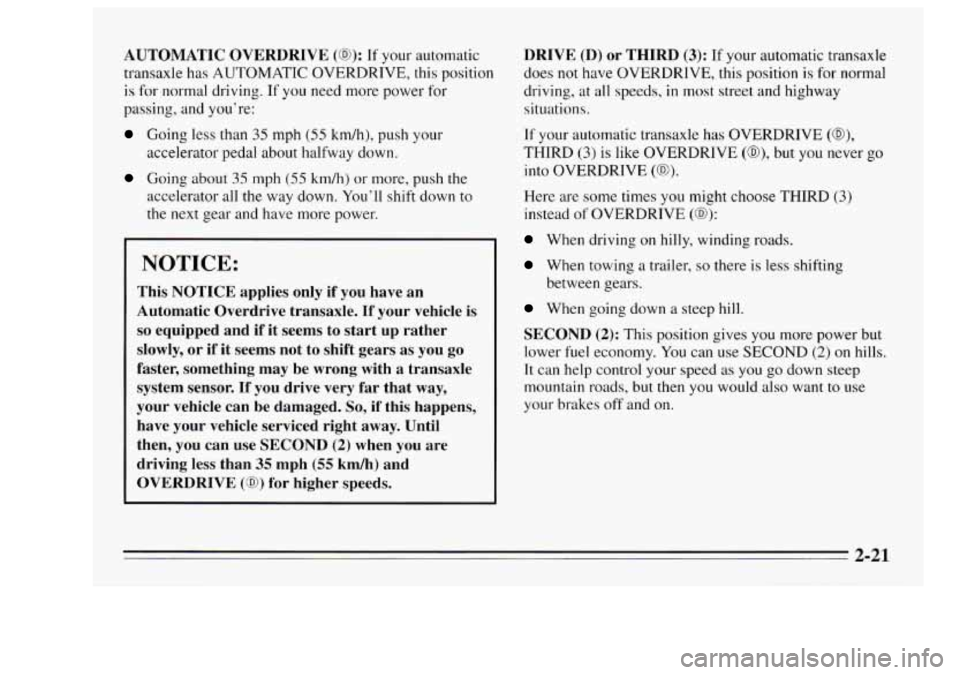
AUTOMATIC OVERDRIVE (a): If your automarlc
transaxle has
AUTOMATIC OVERDRIVE, this position
is for normal driving. If you need more power for
passing, and you’re:
Going less than 35 mph (55 km/h), push your
accelerator pedal about halfway down.
Going about 35 mph (55 km/h) or more, push the
accelerator all the way down. You’ll shift down
to
the next gear and have more power.
NOTICE:
This NOTICE applies only if you have an
Automatic Overdrive transaxle.
If your vehicle is
so equipped and if it seems to start up rather
slowly,
or if it seems not to shift gears as you go
faster, something may be wrong with a transaxle
system sensor. If you drive very
far that way,
your vehicle can be damaged.
So, if this happens,
have your vehicle serviced right away. Until
then, you can use SECOND
(2) when you are
driving less than
35 mph (55 kmk) and
OWRDRIVE
(0) for higher speeds.
DRIVE (D) or THIRD (3): If your automatic transaxle
does not have OVERDRIVE, this position is for normal
driving, at
all speeds, in most street and highway
situations.
If your automatic transaxle has OVERDRIVE (@),
THIRD (3) is like OVERDRIVE (@), but you never go
into OVERDRIVE
(@).
Here are some times you might choose THIRD (3)
instead of OVERDRIVE (a):
When driving on hilly, winding roads.
When towing a trailer, so there is less shifting
between gears.
When going down a steep hill.
SECOND (2): This position gives you more power but
lower
fuel economy. You can use SECOND (2) on hills.
It can help control your speed as you go down steep
mountain roads, but then you would also want to use
your brakes
off and on.
2-21
Page 100 of 340
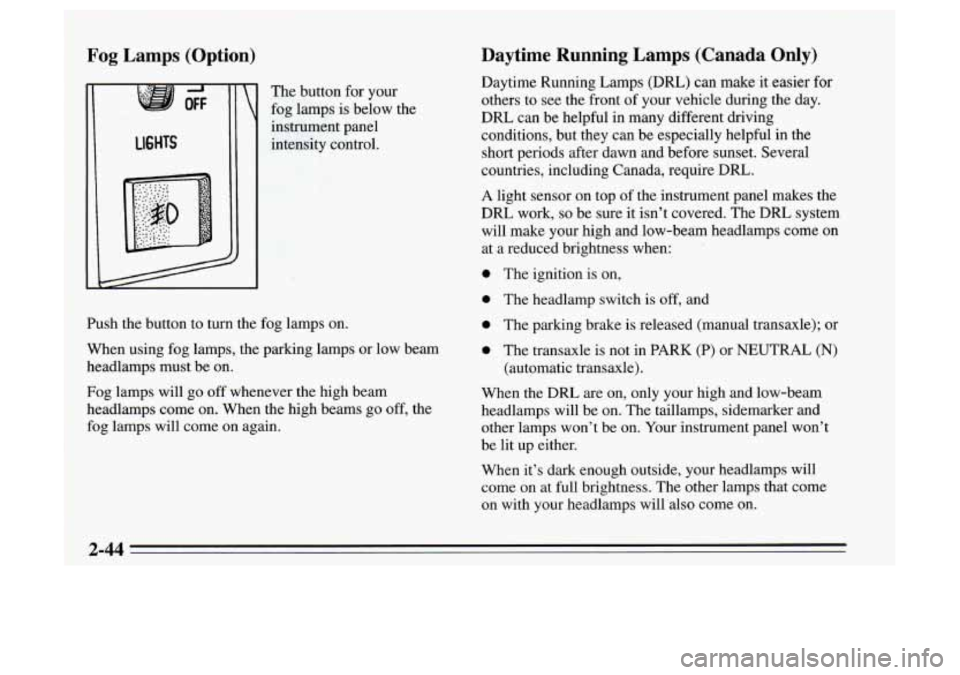
Fog Lamps (Option) Daytime Running Lamps (Canada Only)
7 %.
OFF
LIGHTS
The
button for your
fog lamps is below the
instrument panel
intensity control. Daytime Running
Lamps (DRL) can make it easier for
others to see the front of your vehicle during the day.
DRL can be helpful in many different driving
conditions, but they can
be especially helpful in the
short periods after dawn and before sunset. Several
countries, including Canada, require DRL.
A light sensor on top of the instrument panel makes the
DRL work,
so be sure it isn’t covered. The DRL system
will make your high and low-beam headlamps come on
at a reduced brightness when:
0 The ignition is on,
Push the button to turn the fog lamps on.
When using fog lamps, the parking lamps or low beam
headlamps must be on.
Fog lamps will go off whenever the high beam
headlamps come on. When the high beams go
off, the
fog lamps will come on again.
0 The headlamp switch is off, and
0 The parking brake is released (manual transaxle); or
0 The transaxle is not in PARK (P) or NEUTRAL (N)
(automatic transaxle).
When the DRL are on, only your high and low-beam
headlamps will be on. The taillamps, sidemarker and
other lamps won’t be on. Your instrument panel won’t
be lit up either.
When it’s dark enough outside, your headlamps will
come on at
full brightness. The other lamps that come
on with your headlamps will also come on.
Page 116 of 340
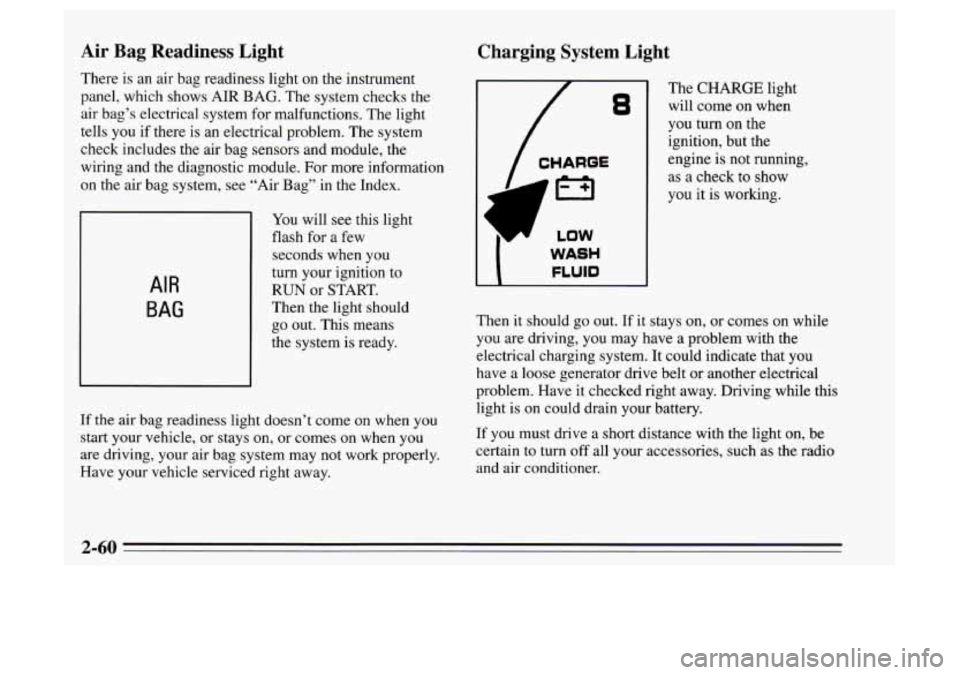
Air Bag Readiness Light
There is an air bag readiness light on the instrument
panel, which shows AIR BAG. The system checks the
air bag’s electrical system for malfunctions. The light
tells
you if there is an electrical problem. The system
check includes the air bag sensors and module, the
wiring and the diagnostic module. For more information
on the air bag system, see “Air Bag” in the Index.
AIR
BAG
You will see this light
flash for a few
seconds when you
turn your ignition to
RUN or START.
Then the light should
go out. This means
the system is ready.
If the air bag readiness light doesn’t come on when you
start your vehicle, or stays on, or comes on when you
are driving, your air bag system may not work properly.
Have your vehicle serviced right away.
Charging System Light
WASH
I FLUID
The CHARGE light
will come on when
you turn on the
ignition, but the
engine is not running,
as a check to show
you it is working.
Then it should go out. If it stays on, or
co !s on while
you are driving, you may have a problem with the
electrical charging system. It could indicate that you
have a loose generator drive belt or another electrical
problem. Have it checked right away. Driving while this
light
is on could drain your battery.
If you must drive
a short distance with the light on, be
certain to turn off all your accessories, such
as the radio
and air conditioner.
2-60
Page 124 of 340
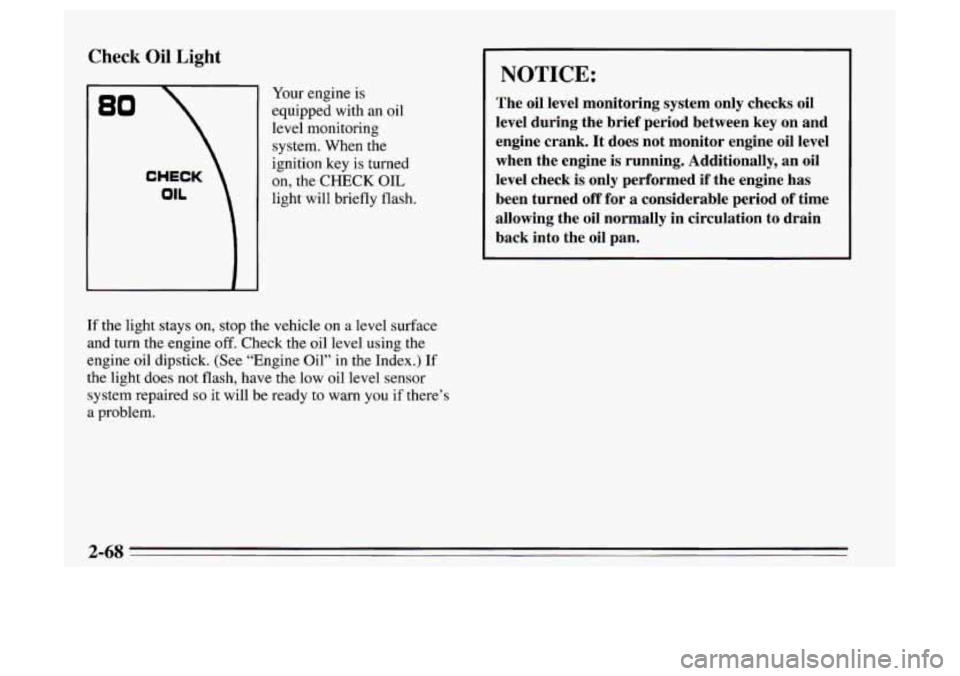
Check Oil Light
80
Your engine is
equipped with
an oil
level monitoring
system. When the
ignition key is turned
on, the CHECK
OIL
light will briefly flash.
If the light stays on, stop the vehicle on a level surface
and turn the engine
off. Check the oil level using the
engine oil dipstick. (See “Engine Oil” in the Index.)
If
the light does not flash, have the low oil level sensor
system repaired
so it will be ready to warn you if there’s
a problem.
I NOTICE:
The oil level monitoring system only checks oil
level during the brief period between key on and
engine crank.
It does not monitor engine oil level
when the engine is running. Additionally, an oil
level check is only performed if the engine has
been turned
off for a considerable period of time
allowing the oil normally in circulation to drain
back into the oil pan.
2-68
Page 214 of 340
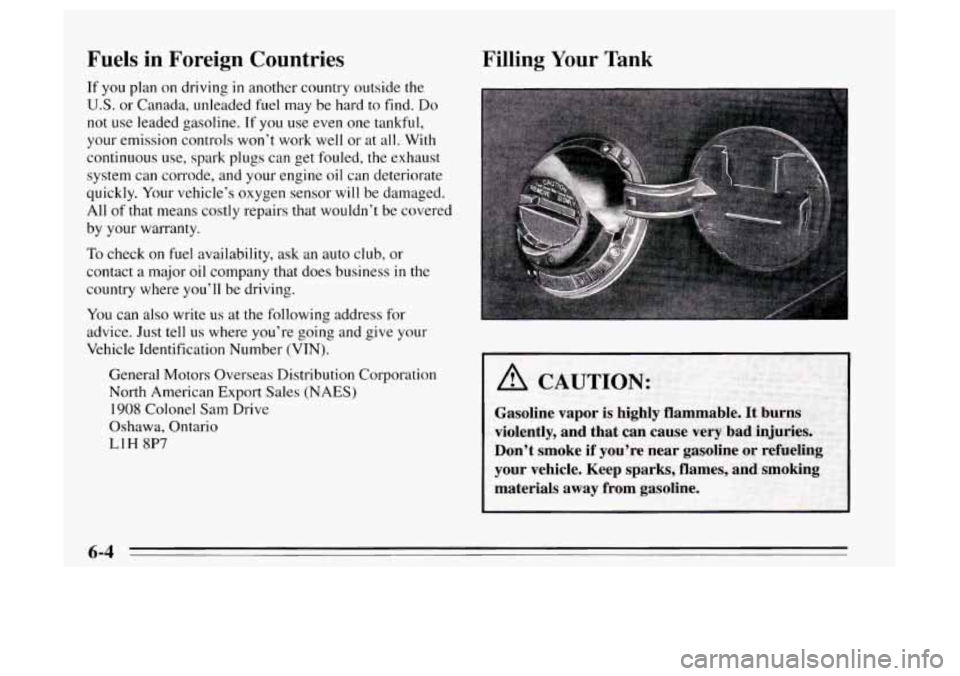
Fuels in Foreign Countries
If you plan on driving in another country outside the
U.S. or Canada, unleaded fuel may be hard to find. Do
not use leaded gasoline. If you use even one tankful,
your emission controls won’t work well or at
all. With
continuous use, spark plugs can get fouled, the exhaust
system can corrode, and your engine
oil can deteriorate
quickly. Your vehicle’s oxygen sensor will be damaged.
All of that means costly repairs that wouldn’t be covered
by your warranty.
To check on fuel availability, ask an auto club, or
contact
a major oil company that does business in the
country where you’ll be driving.
You can
also write us at the following address for
advice. Just tell us where you’re going and give your
Vehicle Identification Number (VIN).
General Motors Overseas Distribution Corporation North American Export Sales
(NAES)
1908 Colonel Sam Drive
Oshawa, Ontario
LIH 8P7
Filling Your Tank
6-4